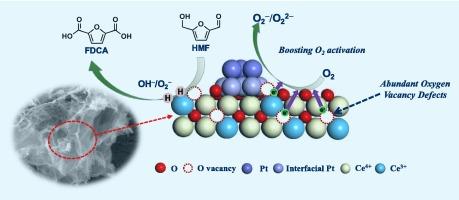Oxygen defect engineering in Pt/CeO2 catalyst for promoted selective oxidation of HMF to FDCA
IF 6.9
2区 材料科学
Q2 CHEMISTRY, PHYSICAL
引用次数: 0
Abstract
Oxygen vacancies play an important role in the oxidation of biomass-derived alcohols and aldehydes using ceria-based catalysts. In this study, a highly oxygen vacancy-defective Pt/H-CeO2 catalyst was synthesized by a straightforward strategy that involved the control of the addition of ascorbic acid and nitric acid. The addition of ascorbic acid, which acted as a pore-forming agent, promoted the hydrolysis, crystallization, and subsequent growth of Ce precursor salt, resulting in the synthesis of H-CeO2 with abundant oxygen vacancy defects and a porous thin sheet-like morphology. However, the addition of nitric acid significantly inhibited the generation of oxygen vacancy defects. The obtained H-CeO2 exhibited significantly increased oxygen vacancy content, active oxygen species, and specific surface area compared with CeO2 with lower oxygen vacancy defects (L-CeO2). These remarkable features led to enhanced catalytic activity of Pt/H-CeO2 for the oxidation of 5-hydroxymethylfurfural (HMF) compared with Pt/L-CeO2. This can be mainly attributed to the enhanced adsorption and activation of O2 molecules by abundant oxygen vacancies, allowing more active oxygen species to participate in the dehydrogenation of HMF. This work provides an example of oxygen defect engineering for ceria-based catalysts to boost the catalytic selective oxidation performance.


Pt/CeO2催化剂的氧缺陷工程促进HMF选择性氧化制备FDCA
氧空位在二氧化铈基催化剂氧化生物质衍生醇和醛的过程中起着重要作用。在本研究中,通过控制抗坏血酸和硝酸的加入,合成了一种高氧空位缺陷Pt/H-CeO2催化剂。抗坏血酸作为成孔剂的加入,促进了Ce前驱体盐的水解、结晶和随后的生长,从而合成了具有丰富氧空位缺陷和多孔薄片状形貌的H-CeO2。而硝酸的加入明显抑制了氧空位缺陷的产生。与氧空位缺陷较低的CeO2 (L-CeO2)相比,得到的H-CeO2的氧空位含量、活性氧种类和比表面积显著增加。这些显著的特征使得Pt/H-CeO2对5-羟甲基糠醛(HMF)的氧化活性比Pt/L-CeO2更强。这主要是由于丰富的氧空位增强了对O2分子的吸附和活化,使更多的活性氧参与HMF的脱氢。本研究为提高氧化铈基催化剂的选择性氧化性能提供了一个氧缺陷工程实例。
本文章由计算机程序翻译,如有差异,请以英文原文为准。
求助全文
约1分钟内获得全文
求助全文
来源期刊

Applied Surface Science
工程技术-材料科学:膜
CiteScore
12.50
自引率
7.50%
发文量
3393
审稿时长
67 days
期刊介绍:
Applied Surface Science covers topics contributing to a better understanding of surfaces, interfaces, nanostructures and their applications. The journal is concerned with scientific research on the atomic and molecular level of material properties determined with specific surface analytical techniques and/or computational methods, as well as the processing of such structures.
文献相关原料
公司名称
产品信息
阿拉丁
Ascorbic acid
阿拉丁
Ethylene glycol
阿拉丁
Hexachloroplatinic acid hexahydrate
阿拉丁
Polyvinylpyrrolidone (PVP)
阿拉丁
Ascorbic acid
阿拉丁
Ethylene glycol
阿拉丁
Hexachloroplatinic acid hexahydrate (H2PtCl6·6H2O)
阿拉丁
Polyvinylpyrrolidone (PVP, MW = 8,000)
 求助内容:
求助内容: 应助结果提醒方式:
应助结果提醒方式:


